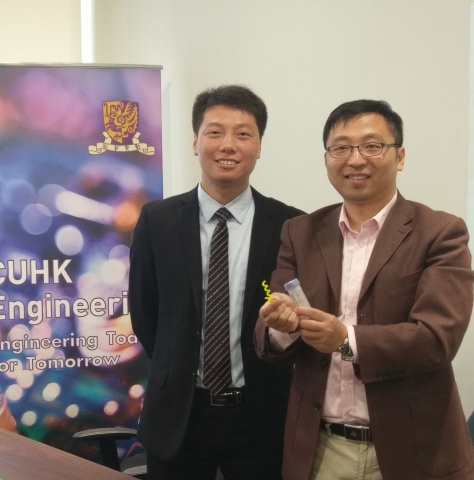A team of scientists led by Prof. Zhang Li, Associate Professor of the Department of Mechanical and Automation Engineering has created a new generation of multi-functional biohybrid microbots. The microrobotic agents are capable of in-vivo tracking using fluorescent imaging and magnetic resonance, and high biodegradability as well as sensing changes in environments associated with their onset of illness. The team also describes the bots as being able to release bio-compounds that selectively attack cancer cells. The breakthrough has been published in Science Robotics, a scientific journal of the American Association for the Advancement of Science (AAAS). Nanorobotics and microrobotics are rapidly developing technology in the biomedical community. Medical micro/nanobots can enter tiny spaces like vessels in the human body, which broadens potential in minimally invasive medical diagnosis and treatment. In contrast with microbots that are made of synthetic materials, Prof. Zhang used spirulina algae, widely sold today as a food substitute in health food shops, as the primary material and plated it with an iron magnetic coating (Iron (II, III) oxide). The research showed that spirulina algae can be safely decomposed in the human body and its biocompounds can selectively attack cancer cells without harming normal cells. This result is expected to provide a new treatment option for cancer. To make it function, the research team soaked the algae in ferromagnetic nanoparticles fluid. A magnetic iron-oxide coating then formed on the surface due to electrostatic interactions. By applying an external rotating magnetic field, the microbot can make directional movement in blood, gastric juice and urine. In addition, the team can control the degradation rate of the algae by adjusting the soaking time to change the thickness of the coating to ensure that microbots have enough time to move to the designated spot for diagnosis and treatment. Also, the naturally fluorescent biological interior and magnetic iron-oxide exterior allow the use of both fluorescence imaging and more powerful magnetic resonance imaging, which are being tested in the abdominal cavity and stomach of rat models, to allow precise positioning and control. This study was conducted by Prof. Zhang and his PhD graduate Dr. Yan Xiaohui, in association with Professor Kostas Kostarelos, Professor of Nanomedicine from the University of Manchester, UK. Prof. Zhang said, “Instead of fabricating a functional microbot from scratch using intricate laboratory techniques and processes, we set out to directly engineer smart materials in nature, which are endowed with favourable functionalities for medical applications owing to their intrinsic chemical composition, structure, and their spontaneous fluorescent characteristics. The results undoubtedly make an important step towards the use of wireless controlled micro-medical robots in clinical applications. We will continue to improve and verify its degradation, safety and efficacy.” Prof. Zhang’s main research interests include micro-/nanorobotics and the making of smart materials for medical robotics. Prof. Zhang and his team are now working to improve the functionality and system of microbots from structural design and material selection, funded by the Research Grants Council (RGC). Various researches done by Prof. Zhang have been the headlines of journals, such as Lab on a Chip, Advanced Materials and Materials Today. Video: www.youtube.com/watch?v=Ccx8bqgkY7M
|
|


